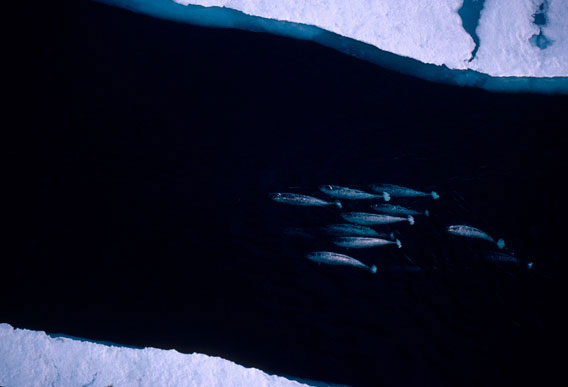- A new program aims to track one of the ocean’s most enigmatic creatures: the narwhal (Monodon monoceros).
- Tagging nine narwhales in August, researchers plan to track the species in order to gain new insights about how the little-known toothed whale will withstand a rapidly melting Arctic due to climate change.
- “[This] is a chance to better understand these animals while their world changes around them. We know narwhals are often associated with sea ice, and we know the sea ice is shrinking.
- WWF is trying to understand how narwhals, as well as all other ice associated animals in the arctic can adapt to a changing environment,” says Peter Ewins with WWF-Canada.

Aerial group of migrating narwhals. Photo by: Doug Allen/WWF.
A new program aims to track one of the ocean’s most enigmatic creatures: the narwhal (Monodon monoceros). Tagging nine narwhales in August, researchers plan to track the species in order to gain new insights about how the little-known toothed whale will withstand a rapidly melting Arctic due to climate change.
“[This] is a chance to better understand these animals while their world changes around them. We know narwhals are often associated with sea ice, and we know the sea ice is shrinking. WWF is trying to understand how narwhals, as well as all other ice associated animals in the arctic can adapt to a changing environment,” says Peter Ewins with WWF-Canada, which is helping support the tracking program. “We can put this knowledge together with existing Inuit knowledge, and we can work with Inuit and other stakeholders to help the animals survive the coming changes.”
Narwhals are listed as Near Threatened by the IUCN Red List with concerns that it could be highly vulnerable to climate impacts in the Arctic. The species could also be imperiled by opening the Arctic to gas and oil drilling and increased shipping lanes. Currently researchers estimate that narwhals number around 80,000 individuals.
The narwhal is most well-known for its single spiraling tusk, which is believed to have contributed to the legend of the unicorn. In males the tusk can grow as long as 3 meters.

Tagging a narwhal. Photo courtesy of WWF.

Researchers release narwhal after tagging it. Photo courtesy of WWF.







